In this ultimate editing guide, I’ll show you how to make an article 100% grammatically correct, and edit, format, and structure it like a pro—even if you’re a complete beginner writer.
I’ll show you examples of how to format articles on Medium, but all platforms are pretty similar.
So, here, our main focus is to create a raw draft and then edit it like a pro to make the article ready for publication.
After that, you can publish it anywhere you want —WordPress, Substack, Medium, Beehiiv, LinkedIn, etc.
Let’s dive right in.
Table of Contents
Write an Engaging Introduction
The first section of this article was an introduction.
You can add an introduction to all kinds of articles. A high-quality intro not only makes the overall article more engaging, but also encourages readers to finish reading it.
So make sure you add an intro by highlighting the main part of the article.
Tell readers what they will get if they read the article.
You can also apply the AIDA model here.
- Attention: Capture the audience’s attention and create brand awareness.
- Interest: Generate interest in your product or service by sharing valuable information and igniting curiosity.
- Desire: Evoke a desire for the product or service by outlining its benefits and addressing the customer’s emotions.
- Action: CTA: Encourage the buyer to interact with your content and take the next step, such as downloading an eBook, purchasing a product, or joining your newsletter.
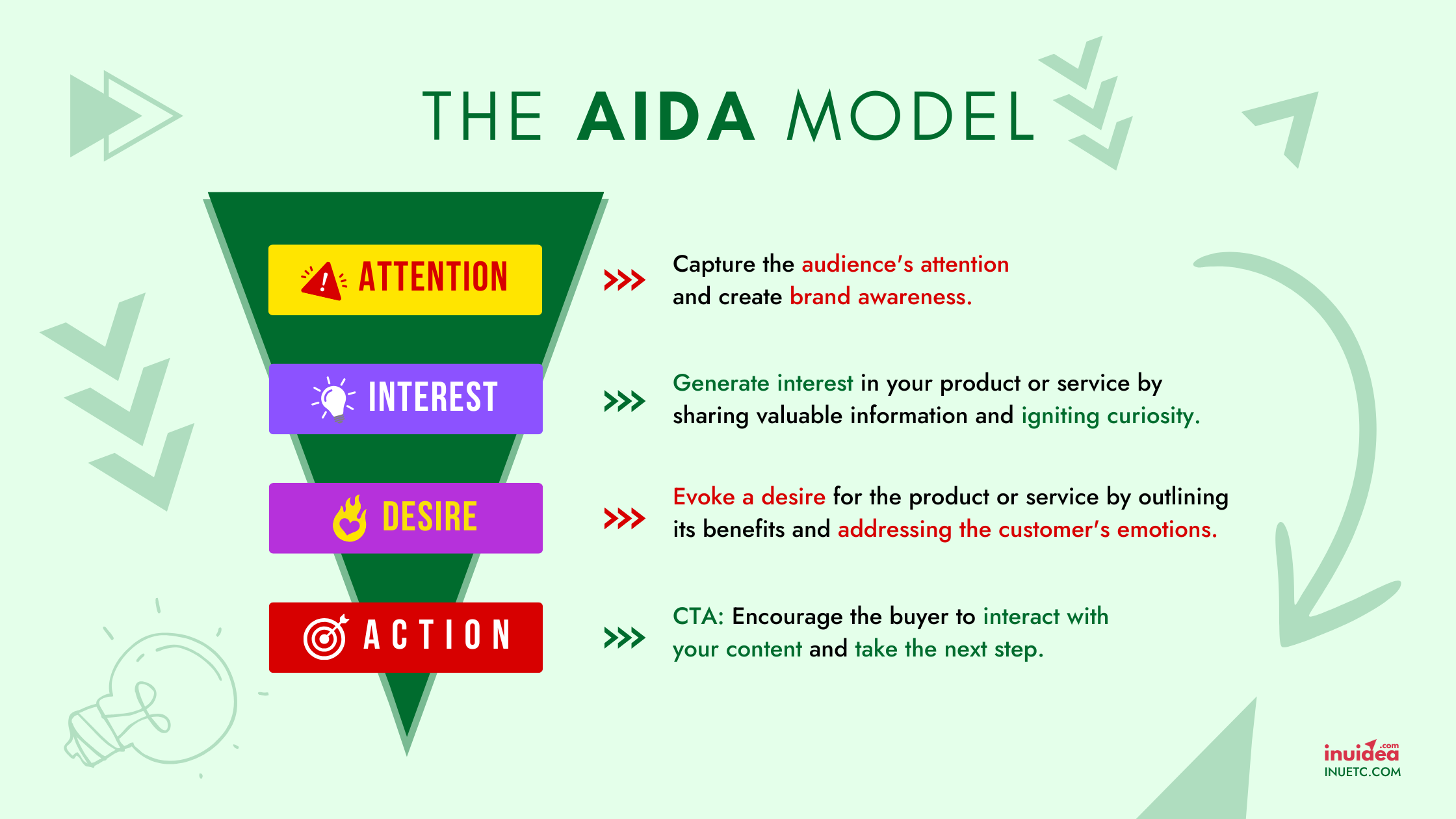
Photo by Inu Etc
Even though the AIDA model is a marketing framework that describes the stages a customer goes through before making a purchase, it also helps copywriters write engaging content, no matter what the end goal is.
Here, ‘Action’ can mean that you want the readers to read the entire article or want them to click your CTA (call to action) in the outro section of your articles.
Titles and Subtitles
You must have a clear and descriptive title and subtitle at the very top of the story.
Almost 80% of people will read your blog post’s headline, but only 20% will actually read the article.
To grab attention, increase curiosity and CTR (Click-Through Rate), you need to use power words, emotional triggers, and relevant keywords in your titles, subtitles, and headlines.
Here are some examples of power words you can use in your titles, subheadings, and headlines:
- Ultimate
- Amazing
- Effortless
- Proven
- Secrets
- Revealed
- Discover
- Top
- Best
- Actionable
- Expert
- Mistakes
- Exclusive
- Free
- Easily
You can also add a Kicker, even though it’s not mandatory.
Watch this video tutorial to learn how to add a Title, Subtitle, and Kicker in Medium articles.
Headings and Paragraphs
The use of subheadings and small paragraphs makes the article more engaging and skimmable.
Also, you should not write more than three to five sentences per paragraph.
Sometimes you can create an effective paragraph using just a single sentence.
Simple language, straightforward sentences, and short paragraphs with more white space significantly improve the readability score.
Write more subheadings, and make your blog post super skimmable (content that can be read quickly to understand the main points) and easy to read for lazy readers.
Format your articles using H2s, and H3s, when appropriate.
Make sure you write all the headings, subheadings, and other necessary points before you write the actual blog posts.
It helps you write long blog posts in less time. You just have to fill in the blanks between the subheadings.
Read more: How to Write Every Day: Forget Perfectionism
Add Bucket Brigades
You may be wondering, “What are bucket brigades?”
Bucket brigades are words and phrases that add a conversational tone to your content, connecting one concept to another. This helps with the overall flow of the writing.
Some examples of bucket brigades are:
- Look at this,
- Sounds familiar?
- Ready?
- Let’s dive in.
- In short:
- Let’s get started.
- Have you noticed?
- Do you know?
- OK, I know what you’re thinking:
- By the way,
- You may be wondering,
Make sure you add some bucket brigades in your article to make your content more conversational and engaging.
Fix Grammatical Errors
I suggest you write your articles in Google Docs. You can directly use tools like Grammarly or the LanguageTool Chrome extension to check your articles for grammatical and spelling errors.
Additionally, you can use Hemingway Editor and Wordtune to identify run-on sentences, complex structures, and areas for improvement.
However,
Don’t rely on Grammarly blindly—it sometimes detects names and brand names as errors, so review its suggestions carefully before making changes.
I recommend keeping the ready-to-publish draft in Google Docs as a backup. Your WordPress blog could be hacked, or an editor on Medium might delete or modify parts of your articles.
By storing the original version on Google Docs, you can always access the unaltered copy of your articles.
Additionally, Google Docs makes it easy to search and organize drafts. When you’re ready to publish on any platform, simply copy and paste the article from Google Docs.
Use ChatGPT to fix Grammatical Errors
You can also use ChatGPT to identify and fix grammatical errors.
However, avoid pasting your entire article into ChatGPT and asking it to fix it. Doing so may result in a completely rewritten article, making it 100% AI-generated.
Instead, use a well-crafted prompt to fix grammatical errors using ChatGPT. Here’s the prompt I use to make sure my articles are 100% grammatically correct:
“Please review my text and tell me if it is grammatically correct. If there are any mistakes, point them out clearly, paragraph by paragraph. Keep in mind that this is a blog post written in a conversational tone, the way I talk, so some informality is acceptable. Just focus on identifying and correcting the errors.”
Just paste the prompt and the complete article in ChatGPT.
ChatGPT will tell you all the grammatical errors you can fix. It’ll show all the mistakes and rooms for improvement, sentence and paragraphs wise.
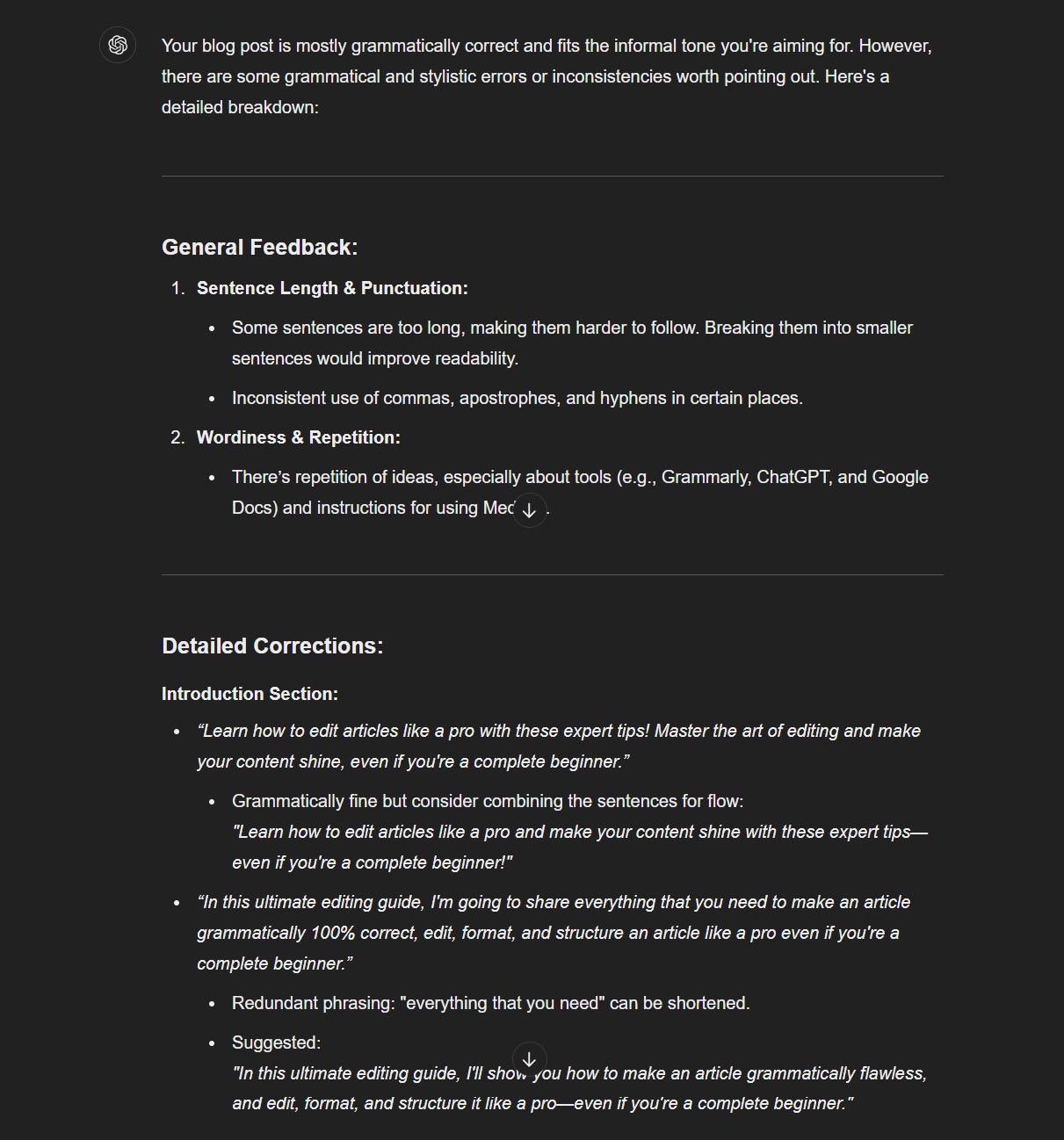
Screenshot by Inu Etc
If your ChatGPT doesn’t provide similar results, make sure to tweak the prompt a little, or ask again to just mention the grammatical errors paragraph wise.
This way you can just copy the most important part from ChatGPT, you can improve your articles paragraph by paragraph, and you can detect all the grammatical errors. You can edit your articles on your own. Also, you can learn grammar from ChatGPT.
If you edit this way, your articles will be 100% original and your own.

Photo by Inu Etc from Pexels
Use Visuals in Articles
Enhance your articles with visuals like, images, screenshots, graphs, infographics, and stock photos.
Avoid using images from Google; instead, use copyright-free stock image sites to download images for free.
On medium, you must add a header image with proper citations.
You can use your own photos or choose from platforms like Pexels and Unsplash.
Since Medium is partnered with Unsplash, you can directly insert Unsplash images into your articles on Medium.
If you use your own photo, credit it with a caption like “Photo by Author.”
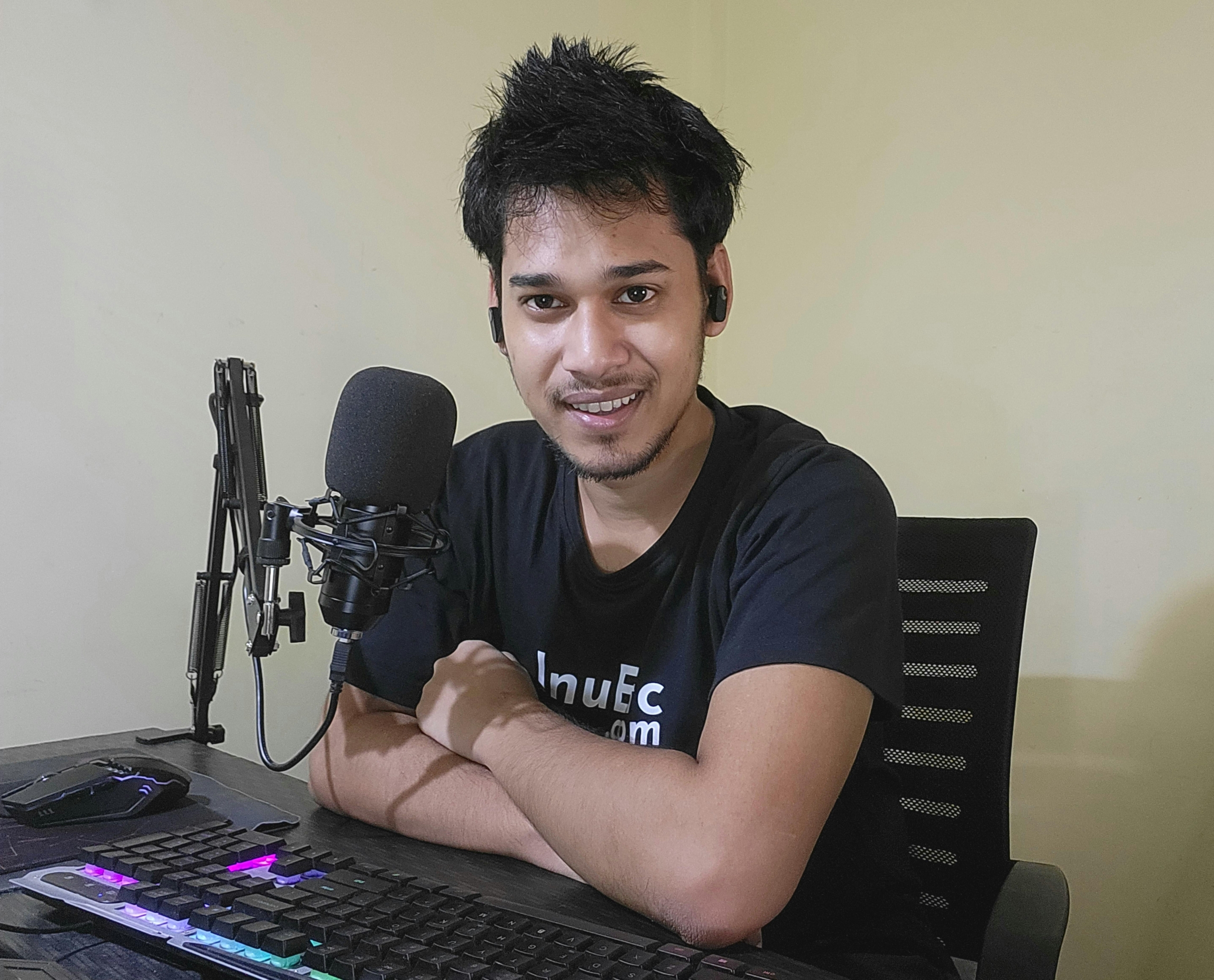
Photo by Author
Alt Text
You must include descriptive alt text for every photo you add.
Alternative text (alt text) is a short, descriptive text that conveys the meaning of an image. It helps visual content accessible to people with vision impairment.
Alt text is read aloud by screen readers for users with visual impairments. It’s necessary for any visual items, such as photos, graphs, charts, and illustrations.
It also helps in SEO, as it gives more information and context to the search engine crawlers about the images and your article.
Medium also boosts articles that are optimized with proper alt texts and, of course, with everything else mentioned in this article, such as high-quality images, proper titles and subtitles, relevant topics, easy-to-understand language, and more.
SEO settings on Medium
Once your article is well-formatted, it’s time to optimize it for search engines (SEO) to rank higher on Google (and other search engines) and get organic traffic.
If you wanna do proper SEO, you must write search engine optimized articles with proper keyword research and all. You can read this article to learn more about SEO. – Basic SEO Techniques To Boost Your Organic Traffic
While writing your draft on Medium, you can visit the ‘More settings’ page to access the SEO settings and add an SEO title and meta description.
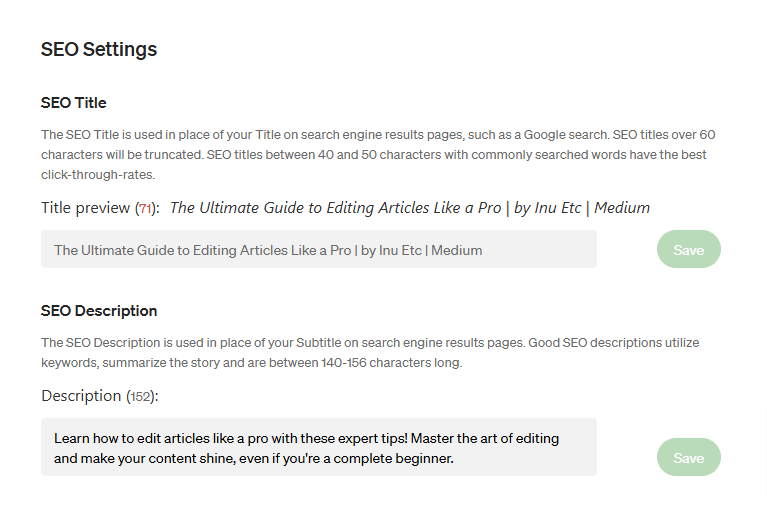
Screenshot by Inu Etc
In a WordPress blog, you can use the RankMath or Yoast SEO plugin to add Open Graph images, meta titles, and meta descriptions.
Topics
Topics are basically tags or categories on Medium. They help organize articles and allow readers to follow their favorite topics, making it easier to receive recommendations related to those topics.
You can see all the recognized topics on the “Explore Topics” page on Medium.
If you want your article to be discovered and provide readers with an idea of its content, you must include five topics whenever you publish on Medium.
You can add topics from the “More settings” option or when you click the “Publish” button, or the “Submit” button (if you’re submitting to a publication).
Join my Medium publication – Work, Earn, Love
Don’t Forget To Add A Conclusion
A conclusion plays a significant role. It will summarize the main points of your article.
You can add a sentence in an interrogative mood. It will actually allow the readers to write their opinion in the comment section.
Ultimately, this kind of conclusion will increase engagement.
Adding a clear call-to-action (CTA) can further drive readers to take specific actions, like subscribing, sharing, leaving a comment, or even buying your services.
For example,
I can write a conclusion like this for this article:
“Editing is a skill that can transform your writing from poor to exceptional.
By implementing these writing and editing tips, you can write articles that are 100% grammatically correct, easy to read, high-quality and professional.
Now that you’ve learned the essentials of editing articles like a pro, what strategies do you already use, or which one will you try first?
Share your thoughts or questions in the comments below—I’d love to hear from you!”
Thanks for reading this article. 💚
If you loved what you read, would you be able to buy me a cup of coffee? It’s okay if you can’t right now.
If you have any questions or if you wanna work with me, feel free to contact me. I’m always available to help young hustlers like you @InuEtc on Instagram.
Keep hustling!
Love, love!
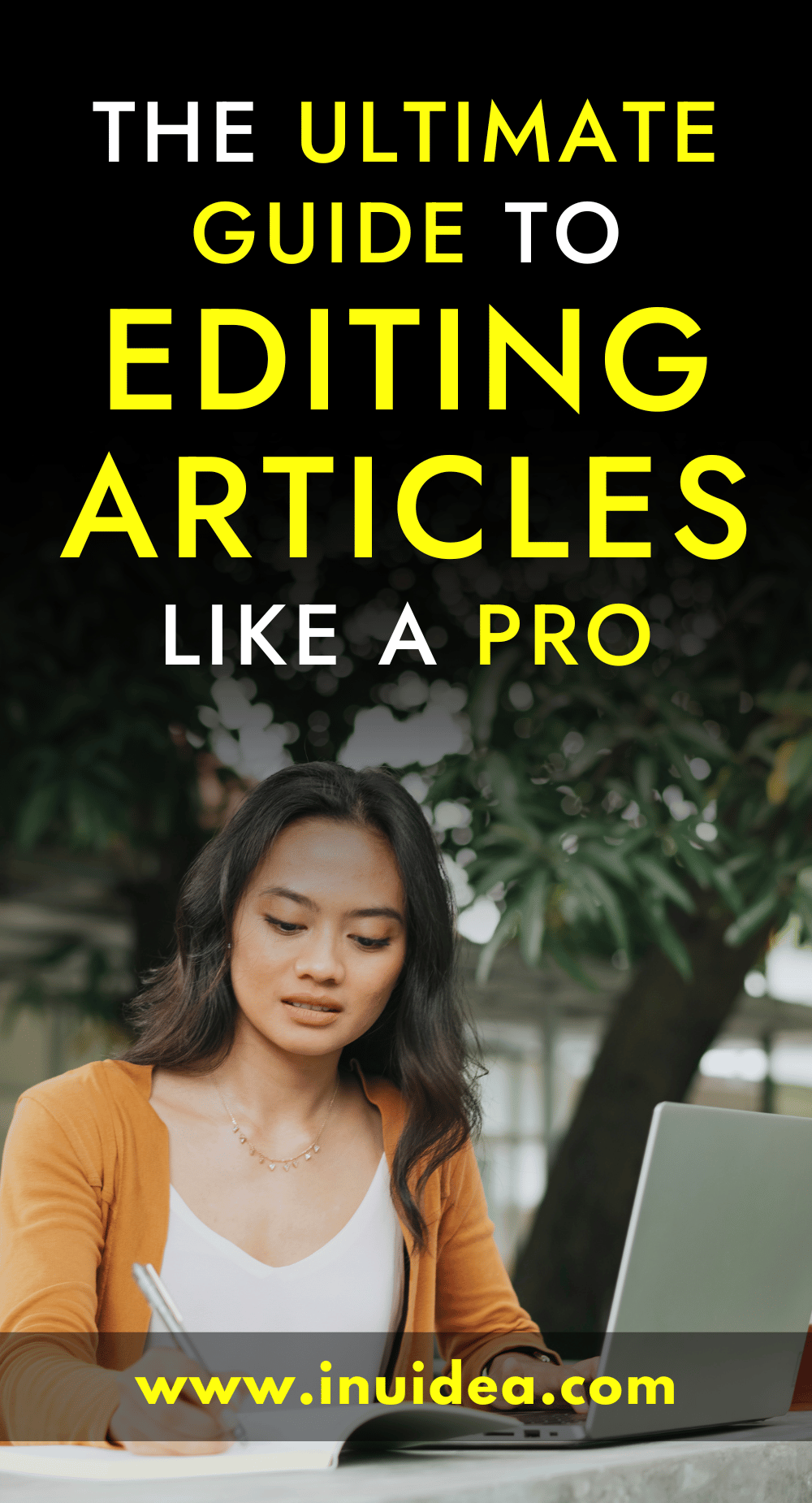
Leave A Comment